Frank ICSE Solutions for Class 9 Chemistry – Elements, Compounds and Mixtures
PAGE NO :41
Solution 1:
- Elements: An element is a pure substance which can neither be broken down into simpler substances nor formed from two or more simpler substances by any known physical or chemical process. It is made of only one kind of atoms. It can be divided into four main categories
- Metals-Iron, magnesium
- Non-metals-Hydrogen, oxygen
- Metalloids-Arsenic, antimony
- Noble gas-Helium, neon
- Compound: A compound is a pure substance that is composed of two or more elements chemically combined in definite proportion by mass.
The physical and chemical properties of a compound are different from those of its constituent elements.Hydrogen gas is combustible and oxygen is supporter of combustion , their compound water which is liquid is neither combustible nor a supporter of combustion. - Mixture: Mixture is a physical combination of two or more substances, whether elements or compounds, which are mixed in any proportion by mass and retain their original properties even after mixing.
Homogeneous mixture: They have same composition and the same properties throughout their entire mass. Example- Salt solution, alloys etc.
Heterogeneous mixture: They have different composition and different properties in different parts of their mass. Example-Mixture of sand and salt, mixture of iron fillings and sulphur etc.
Solution 2:
- Oxygen
- Carbon, hydrogen, Oxygen
- Mercury, Bromine
- Helium
- Oxygen
- Gallium,caesium
- Two noble gases are-
- Helium
- Argon
PAGE NO :42
Solution 3:
Air is a mixture because-
- The composition of air is not fixed i.e. the components may be present in any proportion by mass.
- Components of air i.e. nitrogen, oxygen etc. do not react with each other.
Solution 4:
Elements – Lead, Mercury, Sodium
Mixtures – Air, petrol, ink, gunpowder
Compounds – Common salt, alcohol, sand
Solution 5:
Pure substance – A pure substance is one which is made up of only one kind of particles. These particles may be atoms or molecules.
Example-Sulphur, water.
Impure substance – They are mixtures of two or more chemically different substances mixed in indefinite proportions. The constituent substances retain their properties in the mixture.
Example-Mixture of salt and sand, gunpowder
Solution 6:
Mercury is the metal which is liquid at room temperature and bromine is the non-metal which is liquid at room temperature.
Solution 7:
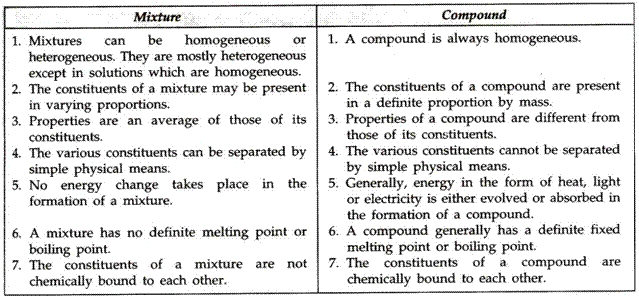
Solution 8:

Solution 9:
Two reasons for believing that copper is a metal and sulphur is a non-metal are:-
- Copper is malleable and ductile while sulphur is neither malleable nor ductile.
- Copper is a good conductor of heat while sulphur is not good conductor of heat.
Solution 10:
Metalloids – The elements which possess properties intermediate between those of the metals and non-metals are called as metalloids. They react with both acids and alkali’s to form salts.
Ex – Arsenic, antimony
Solution 11:
Graphite is a non-metal which is a good conductor of electricity.
Solution 12:

Solution 13:
Mixture is the general name of the materials which contain atleast two pure substances and show the properties of their constituents.
Solution 14:
- Sodium
- Bromine
- Arsenic
- Radon
- Mercury
- Oxalic acid
- Carbon dioxide
Solution 15:
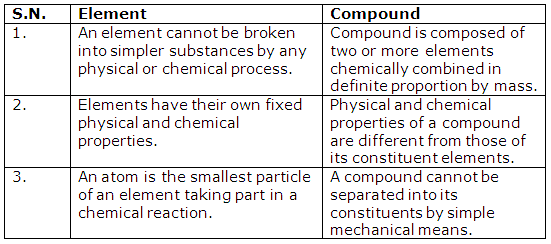
Solution 16:
- simpler substances
- atomic
- same
- mixture of salt and water
- two
Solution 17:
Names of two other mixtures which contain elements only are-
- Bronze
- Duralumin
Solution 18:
- A Molecule – The smallest particle of a substance that retains the chemical and physical properties of the substance and is composed of two or more atoms.
- Atomicity – Atomicity of an element is defined as the number of atoms present in one molecule of that element.
Solution 19:
Since, the constituents of a mixtures may be present in varying proportions so it cannot be expressed by a fixed chemical formula.
Solution 20:
- Air
- Cement
- Milk Sugar solution
Solution 21:
If a mixture of powdered iron and sulphur is heated in a test tube, a black shiny compound iron(II) sulphide (FeS) is formed.
Solution 22:
- Tungsten, Mercury
- Graphite, Iodine
PAGE NO :43
Solution 23:
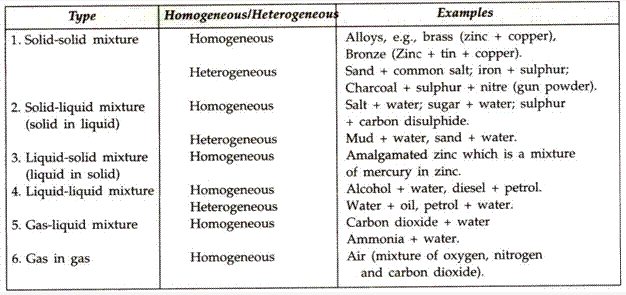
Solution 24:
- Chromatography – The chromatography is a technique of separating pure substances from the mixture.
Advantages of chromatography –- It requires a very small amount of the substance or sample.
- The components retain their individuality during the process.
- Chromatography finds application in easy separation of substances with similar physical and chemical properties.
- Filtration – It is a separation technique for separating a mixture in which one component should be solid and insoluble in the other liquid component.
Example- Barium sulphate in water. - Fractional distillation – It is a technique used to separate two liquids which dissolve in one another.The separation relies on the differences in boiling points of the two liquids.
No, mixture of chloroform and water cannot be separated by this method. - Centrifugation – It is a method for separating the suspended particles of a substance from a liquid in which the mixture is rotated at a high speed in centrifuge machine.
Application – The clay particles in water (which are very fine) can be separated by centrifugation.
Solution 25:
- The vapour state which is obtained by heating solid without passing through liquid state is called sublimate.
- A liquid condensed from vapour in distillation is called distillate.
- The liquid produced after filtering a suspension of a solid in a liquid is called filtrate.
- Supernatant liquid is the upper layer of fluid found after a mixture has been centrifuged.
- If there is a heterogeneous mixture containing an insoluble solid in a liquid, then the solid substance that settle down is called sediment.
Solution 26:
We use fractional distillation to separate alcohol from a mixture of alcohol and water since the difference in boiling point between alcohol and mixture is very less.
Solution 27:
- We obtain pure water from sea water by distillation.
- A sample of pure iodine and sodium chloride is obtained by sublimation.
Solution 28:
The separation of the mixture depends upon-
- Size of the constituents
- Magnetic properties of constituents
- Mass of the constituents
- Solubility of the constituents
- Miscibilities of the constituents
- Boiling point of the constituents
- Diffusion rate of the constituents
Solution 29:
This is a separation technique of solid-solid mixture. This method involves the use of a solvent in which only one of the solid present in the mixture dissolves. Undissolved solid is removed by filtration. Mixture of ammonium chloride and silver chloride is separated by this method.
Solution 30:
- By distillation and fractional distillation we separate the mixture of two liquids.
- Yes, mixture of chloroform (B.P.= 61 oC) and carbon tetrachloride (B.P.=77 oC) be satisfactorily separated by the process of fractional distillation which is used for separating the various fractions of petroleum.
For this purpose we will make two fractionating columns in the apparatus.
Solution 31:
- Solid-solid mixtures
- Magnetic separation method-Separation of iron ore from impurities
- Gravity separation-Mixture of saw dust and sand
- Solvent extraction-Mixture of sulphur and sand
- Solid- liquid mixtures
- Evaporation-Water and sodium chloride
- Distillation-Iodine in chloroform
- Filtration-Barium sulphate in water
- Liquid-liquid mixtures
- By separating funnel-Oil and water mixture
- Distillation-Acetone and water
- Fractional distillation-Ethyl alcohol and water
Solution 32:
The chromatography is the technique of separating pure substances from the mixtures. The chromatographic techniques was first employed by a Russian scientist Michael Tswett in 1903 for the separation of coloured substance from the mixture.
Principle of chromatography: The principle of chromatography is based on the difference in the extent of interaction (absorption) of various substances with a stationary phase and a mobile phase. A substance which interacts strongly with the mobile phase goes ahead of the other substance which interacts strongly with the stationary phase.
Solution 33:
Ink generally contain more than one dye. This mixture of ink is used as moving phase. Different constituents of ink move at different speed. The solvent rises up the filter paper over the spot and carries the different coloured components of ink to different heights on the filter paper. Each spot thus obtained at a particular height on the filter paper contains a particular constituent of the ink. Thus, the components of the ink are separated.
Solution 34:
By the help of fractional distillation we separate the components of liquid air.
Solution 35:
- Increase in weight – Sulphuric acid and iron
- Decrease in weight – Sodium carbonate crystals
- No change in weight – Sodium chloride
Solution 36:
By filtration, we will separate a mixture of chalk powder and water.
Solution 37:
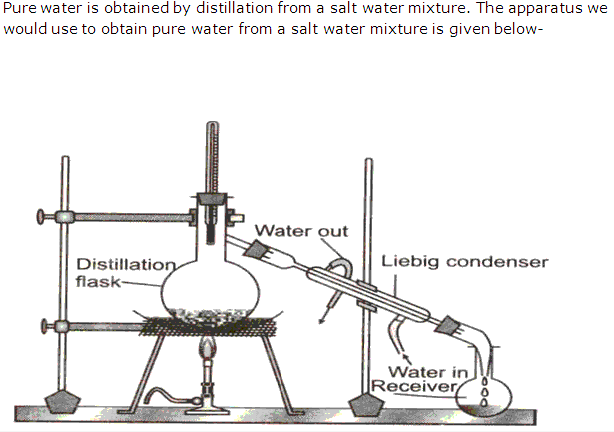
Solution 38:
Fractionating column avoid the collection of distillate and re-distillation of distillate several times during fractional distillation.
Solution 39:
Two pair of liquids which can be separated by using a separating funnel-
- Oil and water
- Chloroform and water
Solution 40:
At first, with the help of magnet, iron nails will separate. Then, by sublimation camphor will separate from common salt.
Solution 41:
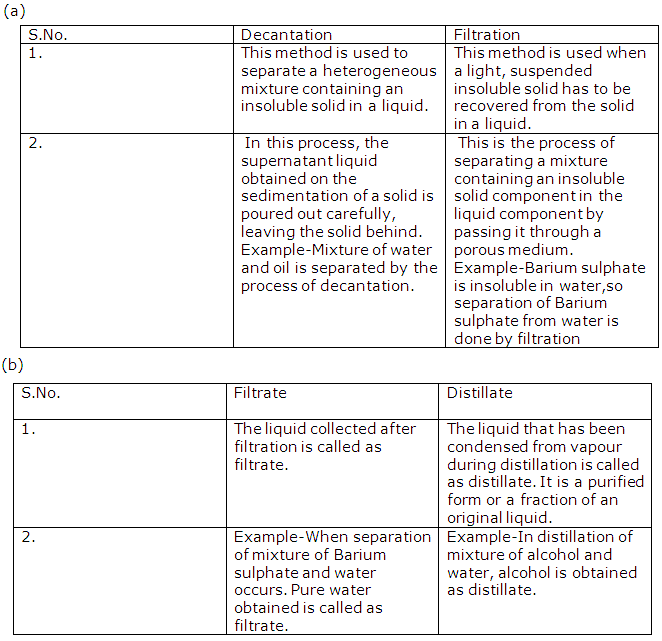
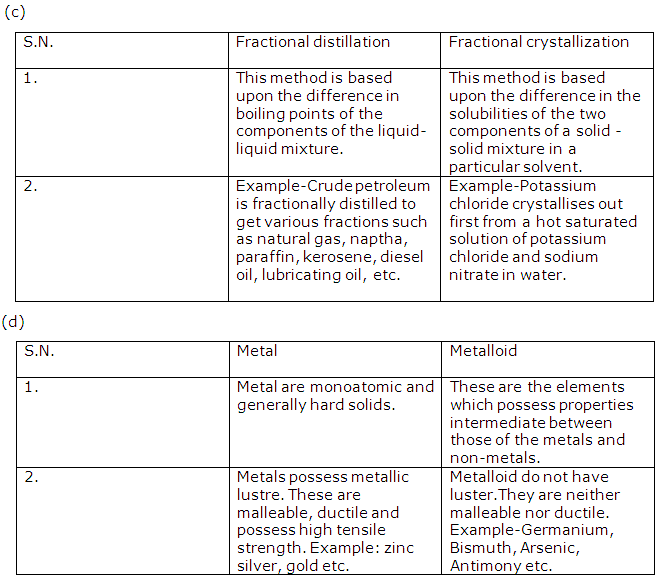
PAGE NO :44
Solution 42:
- When a magnet is moved over ‘X’, iron fillings are pulled away and stick to the magnet. When a magnet is moved over ‘Y’, it remained unaffected.
- When’X’ is treated with carbon disulphide, sulphur dissolves but not iron. While, when’Y’ is treated with carbon disulphide, iron sulphide does not dissolve but sinks to the bottom of the test tube.
- When ‘X’ is treated with dilute HCl, a colourless, odourless gas hydrogen is evolved which burns with a blue flame and is extinguished with a pop sound. While, when ‘Y’ is treated with dilute HCl, a colourless gas with the smell of rotten eggs is evolved which is H2S.
There is difference in the behavior of ‘X’ and ‘Y’ because ‘X’ is a mixture while ‘Y’ is a compound. The component of a mixture do not react chemically, so retain their identity in the mixture while the components of compound react chemically, so do not retain their identity in the compound.
Solution 43:
Centrifugation is used in milk dairies to separate cream from milk dairies.